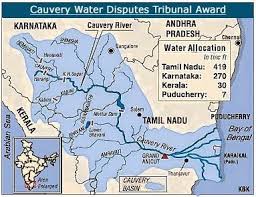Inter-State River Water Disputes (Amendment) Bill 2017
:Sandeepan

For river water disputes we have two acts at present enacted by parliament under Article 262
River-Board-Act,1956
The purpose of this Act was to enable the Union Government to create Boards for Interstate Rivers and river valleys in consultation with State Governments. The objective of Boards is to advise on the inter-state basin to prepare development scheme and to prevent the emergence of conflicts.
Note: Till date, no river board as per above Act has been created.
Inter-StateWaterDisputeAct,1956
It provides the legal framework to address inter-sate water disputes.
In case, if a particular state or states approach to Union Government for the constitution of the tribunal, Central Government should try to resolve the matter by consultation among the aggrieved states. In case, if it does not work, then it may constitute the tribunal.
The Supreme Court and other courts do not have jurisdiction over such disputes — they can interpret verdicts of tribunals.
Issues with present Inter State River Water Dispute Act, 1956:
- Under the present Act, a separate Tribunal has to be established for each dispute. There are eight inter-state water dispute tribunals, including the Ravi and Beas Waters Tribunal and Krishna River Water Dispute Tribunal.
- Currently there is no time limit for adjudication or publication of reports.
- Only three of the eight tribunals have actually given awards accepted by the states.
- Tribunals like those on the Cauvery and Ravi Beas have been in existence for over 26 and 30 years respectively without any award.
- There is no upper age limit for the chairman or the members.
- The disputes’ resolution generally has not been effective- Disputes have recurred, there have been long delays in adjudication and States have not complied with verdicts of tribunals.
Features of the new bill:
- The bill proposes a permanent Inter-State River Water Disputes Tribunal(ISRWDT).
In the current arrangement, tribunals are formed when a river water dispute arises. These are dispute-specific. - The ISRWDT will be an eight-member body comprising serving Supreme Court and high court judges. It will have a chairperson and a vice-chairperson. The members will retire when they are 70 — there was no such limit earlier.
- Each dispute will be referred to a three-member bench and resolution will be time bound. At least on paper, the entire process is restricted to five-and-half years, taking into account all extensions. There is almost no limit on extensions in the current arrangement.
- The bill provides for a DRC (Disputes Resolution Committee)to enable ex-ante negotiated settlements, in place of earlier mediation by the Centre. This is an interesting provision, evidently to avoid disputes advancing to the next stage of legal adjudication.
- The bill says the Centre will set up the DRC with “members from such relevant fields, as it deems fit, for resolving the disputes amicably”.
- The DRC’s functions includes recording data, noting stands and claims of states and reporting facts.
- There is a provision for a data bank and information system. The new bill allows the Centre to appoint or authorise an agency for the purpose, perhaps to draw on the existing capacities of the
Criticism of Bill:
- DRC’s benefits will depend on the mechanism’s efficiency. Unless the DRC is adequately high profile and commands credibility and legitimacy to engage proactively for negotiated settlement between states, it may be relegated to performing perfunctory procedures.
- The arrangement for an agency to create a data bank and information system could hit a roadblock given the tenuous centre-state relations over managing river waters. The challenge is not about gathering data and information, but more about states agreeing over a particular piece of data. The challenge is also about tapping the data to produce knowledge that can be used for decision-making.
- Addressing he challenge of implementing the tribunal’s awards – The Cauvery Water Disputes Tribunal Award, given in 2007, lamented about legal ambiguities which prevented it from recommending an institutional mechanism to implement its award. These ambiguities will persist even after the amendments. The power to devise such mechanisms is with the Centre. But the government is ill-equipped to offer competent and resilient mechanisms. The River Boards Act, 1956, the most potent law available for the purpose — drawn under Entry 56 of the Union List for regulating and developing interstate rivers — has become a dead letter. With this critical gap, implementing tribunal awards will be a huge challenge.


